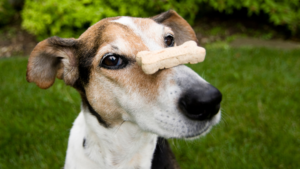When my vet first told me that my beloved Labrador Retriever, Cooper, had diabetes, I was devastated. As a responsible pet parent, I knew I had to learn everything I could about caring for a diabetic dog. An essential part of Cooper’s treatment plan was transitioning him to a special diabetic dog diet with regulated mealtimes and appropriate treats.
I scoured the internet and asked my vet endless questions about what treats I could safely give Cooper. It was tricky finding tasty treats that met the dietary guidelines for diabetic dogs, but we figured it out over time. Now, Cooper’s diabetes is under excellent control, largely thanks to the healthy diabetic dog treats I choose for him.
If your dog was recently diagnosed with diabetes, you’re likely wondering: what treats can I give my diabetic dog? This comprehensive guide covers everything you need to know, from treatment guidelines to the best treatment brands for diabetic pups. Let’s start with the basics.
What Makes a Suitable Diabetic Dog Treat?
The primary goal with diabetic dog treats is keeping your dog’s blood sugar stable. That means choosing ingredients that get digested slowly and don’t cause blood sugar spikes. Here’s what to look for:
Key Ingredients
- Meat products: Quality protein sources like chicken, turkey, beef or fish. These provide energy and keep your dog feeling full.
- High fiber: Ingredients like sweet potato, lentils, pumpkin, and veggies add fiber to slow digestion.
- Low fat: Too much fat makes treats hard to digest. Leaner options are best.
- Complex carbs: Whole grains like brown rice are better than simple carbs like white rice.
- No added sugars: Obviously, extra sugar is off the menu!
Food Preparation
- Dehydrated or low moisture: These treats digest more slowly than moist, chewy kinds.
- Slow digesting: Find treats made to stabilize blood sugar, not spike it.
Following these treatment guidelines keeps your diabetic pup’s system in balance. Now, let’s look at some safe, natural treat options.
Top Natural Treats for Diabetic Dogs
You can choose from unprocessed single-ingredient foods to give your pup a healthy, blood-sugar-friendly snack. Here are some of the best options:
Vegetables
Low-glycemic veggies like green beans, pumpkin, zucchini, and carrots make excellent diabetic dog treats. Since they digest slowly, these fiber-rich veggies won’t cause blood sugar crashes or spikes. Some of my favorite veggies for Cooper include:
- Green beans: A classic choice — low calorie, crunchy, hydrating.
- Pumpkin: Nutrient-dense with vitamin A; supports digestive health.
- Zucchini: Mild flavor and texture dogs love; good source of vitamins C and A.
I dice or slice veggies small or slip whole baby carrots to Cooper for a satisfying crunch. You can also use veggie or bone broth to create savory frozen treats.
Berries
Blueberries offer tasty antioxidants for diabetic dogs. Their smaller size means they won’t significantly impact blood sugar levels — just don’t go overboard on portions.
Meat Products
Select low-fat, minimally processed meat like baked chicken, turkey, or lean beef to add a protein punch. Avoid fatty parts like skin, which are hard to digest.
For easy dispensing, try freeze-dried chicken or single-ingredient jerky. These make portable training treats with no preparation required! Brands like PureBites offer just freeze-dried raw chicken breast in bite-size bits.
Herbs and Seeds
Flax and chia seeds sprinkled on food provide fiber and omega fatty acids for skin and coat health. Parsley is an underrated low-calorie snack with freshening qualities. Throw some on dinner or whip up DIY treats with herbs added.

Best Store-Bought Diabetic Dog Treats
If making homemade dog treats sounds daunting, no worries! Many commercial brands now formulate treats specifically for diabetic pups. Here’s how to spot the best ones:
Check the Label
Flip bags over and analyze ingredients lists to verify the treat fits diabetic guidelines:
- Specifies “for diabetic dogs” on the label
- High protein sources at the top
- Low glycemic carbs/starches further down
- No added sugars or syrups
Let’s highlight beneficial treat ingredients and a high-quality brand to check out.
Sweet Potato
This vibrant orange tuber offers an array of vitamins and minerals and is low glycemic. Sweet potato treats provide a delicious way for diabetic dogs to get these benefits.
Lentils
These tiny legumes rank low on the glycemic index, so they won’t spike blood sugar. They also contain lots of fiber to stabilize digestion — a win-win! Lentils are a standard ingredient in many diabetic dog foods and treats.
DogDeli Dehydrated Treats
One excellent brand I discovered is DogDeli, which makes all kinds of dehydrated treats for dogs. Their diabetic line features USA-sourced chicken, sweet potato, lentils, and antioxidant-packed superfoods like blueberries.
For Cooper, I choose DogDeli Chicken Breast Wraps with sweet potato and their Chicken Jerky treats. He gobbles them up happily at mealtimes without tummy troubles or uncontrolled blood sugar afterward. I appreciate that DogDeli uses recognizable, whole-food ingredients.
Now that you know what makes an excellent diabetic dog treat, let’s cover some key pointers for integrating treats into your pup’s diet.
Feeding Guidelines for Diabetic Dogs
Giving treats is excellent for training, bonding, and showing your dog some love. But with diabetes, sticking to recommended portions matters. Here are some dos and don’ts:
Stick to Vet-Approved Portions
Consult your vet on an appropriate daily treatment allowance based on calories. Don’t go overboard on quantity to prevent obesity and throw off mealtime insulin dosage.
Feed Treats on a Schedule
Time treat dispensing around set mealtimes for consistency. This maintains stable blood sugar rather than random spikes and drops, which can be dangerous.
Adjust Food Portions Accordingly
If treats make up a substantial portion of your diabetic dog’s daily intake, you must scale back kibble at mealtimes to prevent overeating. Check with your veterinarian to coordinate this properly.
Utilize Non-Food Rewards Too
Food shouldn’t be the only way to show your pup affection! Use playtime with fun toys, provide praise and pats when they’re being good, or do a short training session using their kibble.
Balancing tasty treats with proper nutrition keeps diabetic dogs healthy. But your dedicated care and attention make the most significant difference: Monitoring their condition, giving medication on time, and showing unconditional love.
Let Your Diabetic Dog Live Their Best Life!
As a pet parent, caring for a diabetic dog is a big commitment. But it’s incredibly rewarding helping your pup manage this incurable condition. With dietary changes like specialized treats and vets monitoring their treatment plan, most diabetic dogs can still lead entire, energetic lives.
It may seem daunting at first, but you’ve got this! Stay focused on providing medical oversight, proper nutrition, and lots of TLC. Reward your pup for cooperating with you using the tasty and nutritious diabetic treats outlined here.
With extra patience and love from you, your diabetic fur baby will continue lighting up your days for years to come through an attentive care partnership. Monitor their health, celebrate small wins, and celebrate cherished adventures together!

FAQs about What Treats Can I Give My Diabetic Dog
- Can diabetic dogs have any treats? Diabetic dogs can enjoy treats, but they should be low in sugar and carbohydrates to avoid spikes in blood sugar levels.
- Are there any specific ingredients to avoid in diabetic dog treats? Yes, avoid treats with high sugar content, including corn syrup, molasses, and excessive grains.
- Can homemade treats be beneficial for diabetic dogs? Homemade treats can be a great option as they allow you to control the ingredients and ensure they’re suitable for your dog’s condition.
- How often should I give treats to my diabetic dog? Treats should be given in moderation and incorporated into your dog’s daily caloric intake to maintain stable blood sugar levels.
- Should I consult my vet before introducing new treats to my diabetic dog? Yes, always consult your veterinarian before making any changes to your diabetic dog’s diet, including introducing new treats.
- What are some signs that a treat is not suitable for my diabetic dog? Signs that a treat may not be suitable for your diabetic dog include increased thirst, frequent urination, and changes in appetite or energy levels.
Useful Equipment
- Fresh Breathies to finally kiss bad doggie breath goodbye.
- Brush for dog hair.
- Dog Grooming Kit
- Pet Hair Lifter
- The Best High Quality Dog Food
- Pet Merchandise.
Useful Courses
- Brain Training for Dogs – the best & most effective dog training course in the market right now.
So, let us know did you find this article helpful? Are there any other questions you would like us to answer? Let us know in the comment section down below. If you are a dog or pet lover in general here are a few more articles you may find interesting:
RELATED POSTS:
The Ultimate Guide to Dog Boxes 2024
Top 10 Strongest Dog Breeds In The World 2024
Why Do Dogs Breathe Fast? Things You need to Know 2024
Poodles: Everything You Need To Know About Them 2024
Are Male Dogs Stronger Than Female Dogs? Find Out Now! 2024
Huskies - Everything You Need To Know About Them 2024
How to Euthanize a Dog with Benadryl: A Comprehensive Guide 2024
Is Incense Bad for Dogs? A Pet Owner’s Guide 2024
Golden Retrievers - Everything You Need To Know 2024
Pit Bulls - Everything You Need To Know 2024
The Best Dog Houses For Your Dog In 2024
How To Teach Your Dog To Shake : Step by Step Guide 2024

